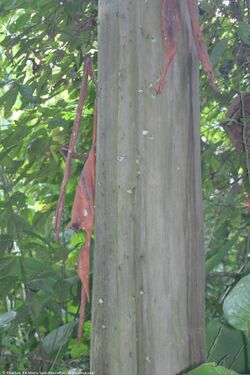Biology:Calycophyllum spruceanum
| Capirona, Mulateiro | |
|---|---|

| |
| Calycophyllum spruceanum in the Amazon Rainforest of Ecuador | |
| Scientific classification | |
| Kingdom: | |
| Phylum: | |
| (unranked): | |
| (unranked): | |
| Order: | |
| Family: | |
| Subfamily: | |
| Tribe: | |
| Genus: | |
| Species: | C. spruceanum
|
| Binomial name | |
| Calycophyllum spruceanum (Benth.) K.Schum.
| |
| Synonyms[1] | |
| |
Calycophyllum spruceanum,[2] common name capirona, is a canopy tree indigenous from the Amazon rainforest.
Description
A tree can grow up to a height of 30 meters.
During the summer months, it produces an abundance of white, aromatic flowers, which are followed by elongated seed pods with 3-5 seeds inside.[3]
Its bark is shed periodically to avoid lichens, fungi, epiphytes and lianas.
Once or twice a year, it sheds off its bark entirely. The smooth green bark underneath is somewhat like a sunburnt human. The older the tree, the more of its bark will be unpeeled, creeping up its trunk. It grows white or green flowers between March and April. It fruits between July and November, seeds are dispersed by the wind and water.[4] Its wood is used for parquet.[5]
Uses
The dried bark is used to treat fungus on the skin. Used also as an antidiabetic and for eye infections. This tree avoids lichens, fungi, epiphytes and lianas, by getting rid of its bark.
The plants grows extremely fast, within eight years. The wood is often cut for lumber.
Region of growth
Calycophyllum spruceanum grows in the South American countries of Bolivia, Colombia, Brazil , Ecuador, and Peru.[6]
References
- ↑ The Plant List
- ↑ Schumann, Karl Moritz in Martius, Carl (Karl) Friedrich Philipp von. 1889. Flora Brasiliensis 6(6): 191
- ↑ "Database file for Mulateiro - Calycophyllum spruceanum". http://www.rain-tree.com/mulaterio.htm.
- ↑ Ugarte, Leoncio. "Índice de Sitio (IS) de Calycophyllum spruceanum Benth. en relación con la altura dominante del rodal en ensayos de plantación en la Cuenca del Aguaytía, Ucayali, Perú". Ecologia Aplicada Volumen 9, N os 1 y 2 / Enero - Diciembre 2010. UNALM. http://www.lamolina.edu.pe/ecolapl/Contenido_Vol_9.pdf.
- ↑ * "Capirona, naked tree". http://amazonwiki.org/index.php?title=Capirona,_Naked_tree.
- ↑
Further reading
- Polesna, L.; Polesny, Z.; Clavo, M. Z.; Hansson, A.; Kokoska, L. (2011). "Ethnopharmacological inventory of plants used in Coronel Portillo Province of Ucayali Department, Peru". Pharmaceutical Biology 49 (2): 125–136. doi:10.3109/13880209.2010.504927. PMID 20942601.
External links
- Ayahuasca Foundation (Iquitos, Peru), capirona, Calycophyllum spruceanum
- Rain Tree (Milam County Texas USA), database file for mulateiro, Calycophyllum spruceanum
Wikidata ☰ Q10346240 entry

